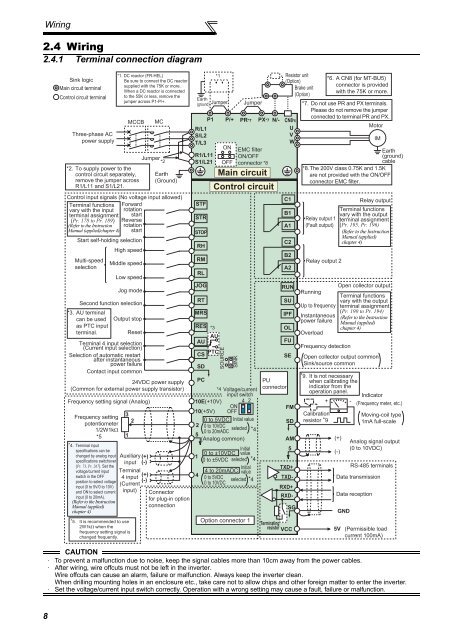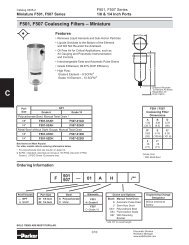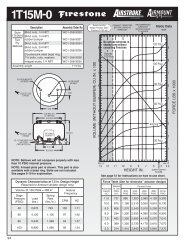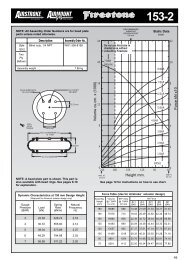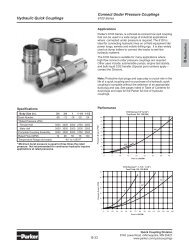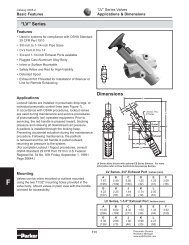FR-F700 INSTRUCTION MANUAL (BASIC) - MRO Stop
FR-F700 INSTRUCTION MANUAL (BASIC) - MRO Stop
FR-F700 INSTRUCTION MANUAL (BASIC) - MRO Stop
- No tags were found...
Create successful ePaper yourself
Turn your PDF publications into a flip-book with our unique Google optimized e-Paper software.
Wiring2.4 Wiring2.4.1 Terminal connection diagramSink logicMain circuit terminalControl circuit terminalThree-phase ACpower supplyMCCB*2. To supply power to thecontrol circuit separately,remove the jumper acrossR1/L11 and S1/L21.Frequency setting signal (Analog)Frequency settingpotentiometer1/2W1kΩ*5321Auxiliary (+)input (-)Terminal4 input(Currentinput)*5. It is recommended to use2W1kΩ when thefrequency setting signal ischanged frequently.MCJumper*2Control input signals (No voltage input allowed)Terminal functions Forwardvary with the input rotationterminal assignment start(Pr. 178 to Pr. 189) Reverse(Refer to the InstructionManual (applied)chapter 4)Multi-speedselection*3. AU terminalcan be usedas PTC inputterminal.rotationstartStart self-holding selectionHigh speedMiddle speedLow speedJog modeSecond function selectionTerminal 4 input selection(Current input selection)Selection of automatic restartafter instantaneouspower failureContact input common*4. Terminal inputspecifications can bechanged by analog inputspecifications switchover(Pr. 73, Pr. 267). Set thevoltage/current inputswitch in the OFFposition to select voltageinput (0 to 5V/0 to 10V)and ON to select currentinput (0 to 20mA).Output stopReset(+)(-)Earth(Ground)24VDC power supply(Common for external power supply transistor)(Refer to the InstructionManual (applied)chapter 4)*1. DC reactor (<strong>FR</strong>-HEL)Be sure to connect the DC reactorsupplied with the 75K or more.When a DC reactor is connectedto the 55K or less, remove thejumper across P1-P/+.Connectorfor plug-in optionconnectionEarth(ground) JumperR/L1S/L2T/L3R1/L11S1/L21STFSTRSTOPRHRMRLJOGRTMRSP1*1RES *3AUAUCSPTCMain circuitControl circuitSOURCEP/+Relay output 1(Fault output)CAUTION· To prevent a malfunction due to noise, keep the signal cables more than 10cm away from the power cables.· After wiring, wire offcuts must not be left in the inverter.Wire offcuts can cause an alarm, failure or malfunction. Always keep the inverter clean.When drilling mounting holes in an enclosure etc., take care not to allow chips and other foreign matter to enter the inverter.· Set the voltage/current input switch correctly. Operation with a wrong setting may cause a fault, failure or malfunction.SINKJumper *7.PR*7SE Open collector output commonSDSink/source commonPCPU*9. It is not necessarywhen calibrating theconnector indicator from the*4 Voltage/currentoperation panel.input switchIndicator10E(+10V) 4 2+ -(Frequency meter, etc.)ONFM10(+5V) OFFCalibrationMoving-coil type0 to 5VDC Initial valueSD resistor *91mA full-scale2 0 to 10VDCselected0 to 20mADC*45(Analog common)AM(+)Analog signal output1Initial5(0 to 10VDC)0 to ±10VDC value(-)0 to ±5VDC selected *4InitialTXD+RS-485 terminals4 to 20mADC value40 to 5VDCTXD-Data transmission0 to 10VDCRXD+RXD-Data receptionSGGNDPX*7 N/-ON EMC filterON/OFFOFF connector *8CN8*6UVWC1B1A1C2B2A2RUNSUIPFOLFUTerminatingresistor VCCResistor unit(Option)Brake unit(Option)Do not use PR and PX terminals.Please do not remove the jumperconnected to terminal PR and PX.Relay output 2RunningUp to frequencyInstantaneouspower failureOverloadFrequency detectionMotorIMRelay outputTerminal functionsvary with the outputterminal assignment(Pr. 195, Pr. 196)(Refer to the InstructionManual (applied)chapter 4)Open collector outputTerminal functionsvary with the outputterminal assignment(Pr. 190 to Pr. 194)(Refer to the InstructionManual (applied)chapter 4)Option connector 1*6. A CN8 (for MT-BU5)connector is providedwith the 75K or more.Earth(ground)cable*8.The 200V class 0.75K and 1.5Kare not provided with the ON/OFFconnector EMC filter.5V(Permissible loadcurrent 100mA)8


